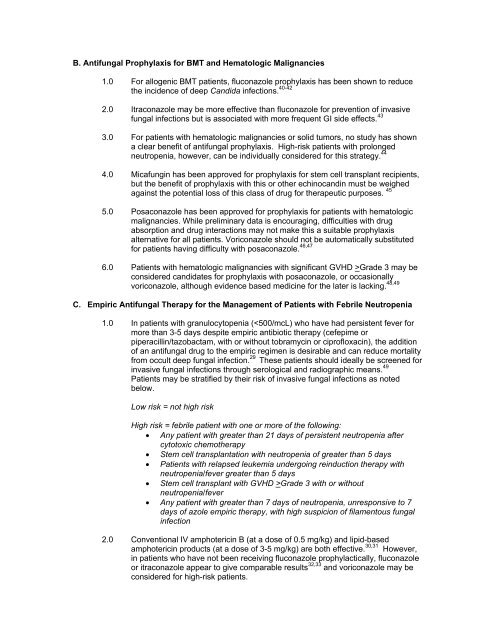Antimicrobial Use Guidelines (AMUG) version 21 - UW Health
Antimicrobial Use Guidelines (AMUG) version 21 - UW Health
Antimicrobial Use Guidelines (AMUG) version 21 - UW Health
Create successful ePaper yourself
Turn your PDF publications into a flip-book with our unique Google optimized e-Paper software.
B. Antifungal Prophylaxis for BMT and Hematologic Malignancies1.0 For allogenic BMT patients, fluconazole prophylaxis has been shown to reducethe incidence of deep Candida infections. 40-422.0 Itraconazole may be more effective than fluconazole for prevention of invasivefungal infections but is associated with more frequent GI side effects. 433.0 For patients with hematologic malignancies or solid tumors, no study has showna clear benefit of antifungal prophylaxis. High-risk patients with prolongedneutropenia, however, can be individually considered for this strategy. 444.0 Micafungin has been approved for prophylaxis for stem cell transplant recipients,but the benefit of prophylaxis with this or other echinocandin must be weighedagainst the potential loss of this class of drug for therapeutic purposes. 455.0 Posaconazole has been approved for prophylaxis for patients with hematologicmalignancies. While preliminary data is encouraging, difficulties with drugabsorption and drug interactions may not make this a suitable prophylaxisalternative for all patients. Voriconazole should not be automatically substitutedfor patients having difficulty with posaconazole. 46,476.0 Patients with hematologic malignancies with significant GVHD >Grade 3 may beconsidered candidates for prophylaxis with posaconazole, or occasionallyvoriconazole, although evidence based medicine for the later is lacking. 48,49C. Empiric Antifungal Therapy for the Management of Patients with Febrile Neutropenia1.0 In patients with granulocytopenia (Grade 3 with or withoutneutropenia/fever• Any patient with greater than 7 days of neutropenia, unresponsive to 7days of azole empiric therapy, with high suspicion of filamentous fungalinfection2.0 Conventional IV amphotericin B (at a dose of 0.5 mg/kg) and lipid-basedamphotericin products (at a dose of 3-5 mg/kg) are both effective. 30,31 However,in patients who have not been receiving fluconazole prophylactically, fluconazoleor itraconazole appear to give comparable results 32,33 and voriconazole may beconsidered for high-risk patients.
















